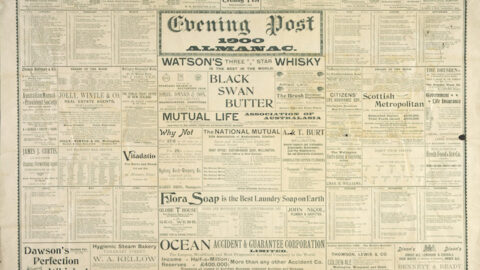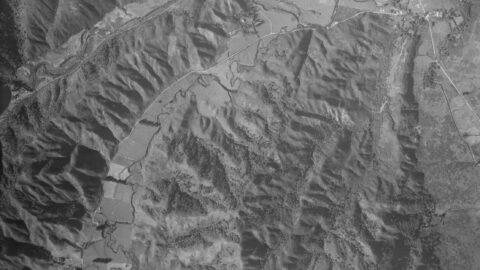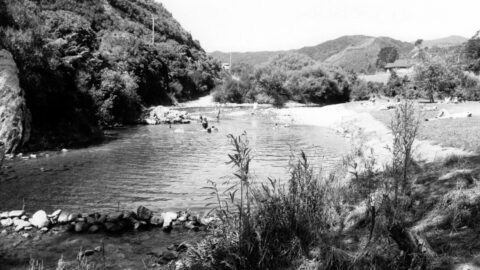THE WAINUIOMATA WATER WORKS
A visit of inspection to the Wainuiomata Valley waterworks, now in course of progress by the City Corporation, was paid on Saturday last by the Mayor of the City, Councillors Maginnity, Greenfield, and Brown, and Mr Baird, the City Surveyor. The party was augmented by the Mayor of Dunedin (Mr Ross), and Messrs Stewart and Turnbull, M.H.R.’s. The visitors were conducted by the Mayor and the City Surveyor along the whole of the line from the Lower Hutt township to the Wainui Stream at the point where it is intended the river shall be stored with a view of its waters being conveyed to the city for the use of the citizens.
The scheme is a most comprehensive one, and, although the supply is calculated to be sufficient for the use of the inhabitants of Wellington, calculated at its present rate of progression and estimated on the average increase of the population, the cost of the undertaking is comparatively small compared with the waterworks of older, larger, and wealthier cities, such as Glasgow and Melbourne. The visitors from the South on Saturday were greatly impressed with the magnitude of the work and the comprehensive, yet simple, character of the whole scheme. The chief characteristic of the work, indeed, is its simplicity and the total absence of any serious engineering difficulty.
The old Kaiwarra waterworks has answered its day. Conceived and carried out at the time the inhabitants of the city numbered at the most 5000, it answered the object for which it was called into being; but, as the city extended, the capacity of the water supply was found to be far less than the yearly growing requirements. At this juncture, about June 1878, Mr W. Clark, C.E., at the request of the Corporation, visited several proposed sites, none of which met with his approval until Mr Baird, the present City Surveyor, suggested the Wainuiomata Valley. The spot was inspected and favourably viewed by Mr Clark, who recommended the scheme which is now being carried out by the City Council.
The future reservoir is a natural basin capable of storing water sufficient to supply a population quadruple that of Wellington for several months, providing the stream from any unforeseen circumstances becomes dry. The labour in connection with the clearing of this natural reservoir has proved but slight and consists of the expenditure of a few days’ work in cleaning out some waterholes. The stream will be easily dammed up at its outlet, which is a narrow neck, by a concrete weir having the usual by-wash gates, &c. The race tops the river at a point at the head of the dam, and will convey the water to a well situated near Sinclair’s sawmills, about two miles from the basin.
The well will be formed of concrete and will be 56 feet deep, with a diameter of 8 feet, sunk in the rock. It will be fitted with valves, with a view to its being emptied for cleaning, &c. At the head of the race is an iron wire screen, and the top of the well will also be furnished with a copper screen, which will prevent any large foreign substances entering the mains. The object of the well is obvious, and it is that the descending column of water may gain sufficient impetus to force itself up the Wainui Hill into the tunnel, which is connected with the main service leading to the city. It is at the head of the well that the supply is regulated and controlled by means of the valves already referred to.
After leaving the tunnel, the fall is amply sufficient to drive the water into the city. The engineering difficulties of the scheme are infinitesimal, and the only obstacle to its fruition is the excavation of the tunnel through the hill and the manual labour of laying the mains. The Wainuiomata supply, however, is capable of being extended considerably and, comparatively speaking, at a small additional outlay, by tapping the Orongorongo River. It is estimated that an additional flow of 3,000,000 gallons per day could be diverted into the Wainuiomata Valley by piercing a tunnel of seven chains in length through a narrow ridge declining into the valley.
Figures are invariably dry reading, but in this instance, they will be read with some degree of interest. The height of the water at the head of the dam is 412 feet above sea level; at the end of the water race, it is 307 feet above sea level, whilst the head of the water available for the use of the city at the mouth of the tunnel is 369 feet. The long tunnel, so frequently referred to, is the most interesting portion of the work to a layman, presenting, as it does, to a casual observer, the only engineering difficulty in the whole of the works.
The original contract was let for a distance of 2310 feet to Mr Oakes, at £1953, including the brickwork. This contract is the one which delays the completion of the scheme, and, notwithstanding that Mr Oakes employs gangs of men both night and day at each end, it will take him all his time to complete his work within the time specified in the contract. The only difficulty Mr Oakes has to contend with is the smallness of the drive, in which only two men can work at a time. The material is a soft, bluish conglomerate of clay and quartz, resembling in a slight degree plumbago. Every foot has to be timbered as it is taken out, after which the drive will be bricked in and concreted. The exceptionally dry summer experienced last year had the effect of hastening the work, but it is anticipated that the water from the Wainuiomata River will not be turned on until Christmas 1882.
The contracts in connection with the work let so far are as follows: Contracts completed outside the city:
- Formation of track to site of dam, Oakes;
- Formation of track for Messrs Sinclair’s tram-line, £873,
- Kelleher and Co.; clearing site for reservoir,
- Wood; pipe-laying along Petone Beach, 147 chains, £750,
- Lockie; pipe-laying from Hutt River to foot of Waiwetu Hill, 72 chains, £300, Secular and Co.;
- Pipe-laying in Wainui Valley from Black Creek along road, 137 chains, £481, Forrell and Co.
Works under contract outside the city:
- Long Tunnel contract, 2310 feet tunnel and other works in connection, £1983, Oakes;
- Black Creek Tunnel, contract, 435 feet tunnel and other works in connection, £284, Coleman;
- Formation of track and laying pipes up Waiwetu Hill to mouth tunnel, £300, Oakes;
- Erection of bridges across Hutt River, £4343, W. Balisa and Co.;
- Construction of concrete water race, £7440, Oakes;
- Laying pipes across swamp to tunnel entrance, 25 chains, £119, Oakes.
In addition to the works above-mentioned as in progress or completed in connection with this scheme outside of the city, the following work has been done or is under contract within the city. Completed: Laying water mains of various sizes in Tory, Taranaki, Arthur, Ghuznee, Cuba, Manners, Willis, Upper Willis, Featherston, Bunny, Murphy, Mulgrave, Charlotte, and Molesworth (part) streets; Cambridge Terrace, Basin Reserve, Lambton Quay, and Thorndon Quay to the junction of Hutt Road—a total distance of about 6½ miles, at a cost of about £1700, the contractors being, for their individual portions, Messrs Kelleher and Bay, McMahon and O’Neil, Lyon and Leonory.
The works are as follows: Laying water mains of various sizes in Adelaide Road, Tinakori Road, and Molesworth Street, estimated length about 1½ miles, estimated cost, £250, the contractors being Mr Brett and Mr Leonory. The supply of pipes is under contract to Messrs Laidlaw of Glasgow at £7 14s per ton; £13 per ton for special castings, and other fittings, &c., at schedule prices. Mr G. McKurdy has the contract for cartage of the pipes from the Petone and Lower Hutt stations to their destinations as far as the dam site at schedule rates.
The work to be yet let, so as to complete the whole scheme, is the pipe-laying along Hutt Road. The balance of the pipes for this work is now being discharged out of the Berwickshire and Algoa Bay. The pipe-laying between the end of Farrell’s contract and the hill, the pipe-laying through the long tunnel, and the construction of the dam are still outstanding. The work yet to be accomplished is very great, but that it will be completed at the earliest opportunity is no less certain. All concerned in the work are enthusiastic and confident. The contractors exhibit a laudable anxiety to carry out their contracts faithfully, and the City Surveyor, Mr Baird, expresses himself as being satisfied with the work performed by the contractors.
Within the city, the reticulation of the streets is thorough, or, at any rate, will be when the contracts accepted by the Corporation last week are completed. The very latest improvements, so far as street stand-pipe appliances are concerned, have been provided in anticipation of the new waterworks scheme. The barques Berwickshire and Algoa Bay are discharging plant wrought by the most experienced hydraulic Scottish engineers, and within a very short time the city will be enabled to boast of the latest and most improved water-supply plant in the Southern Hemisphere.
Stand-pipes are being landed, which are intended to be erected at the intersections of the principal thoroughfares, taking the place of the old-fashioned hydrants or fire-plugs. These stands will prove both ornamental and useful to the thoroughfares and may be easily adapted as street drinking fountains. The stands are a great improvement upon the present fire plugs, as the fullest pressure is obtained without the slightest friction; and in case of fire, four heads of water are obtainable. The old hydrants will still be maintained under the new waterworks, consequently reducing the chances of a conflagration gaining an advantage to a minimum.
The contemplated average supply from the Wainuiomata has not been estimated at haphazard. In 18 of the principal cities of the United Kingdom, the daily average consumption has been calculated at 25.7 gallons per head; the highest is 53 gallons for the City of Glasgow, and the lowest is Norwich, which consumes 11 gallons per day. Taking this calculation as a basis, and supposing the population of Wellington to be 50,000, the Wainuiomata scheme will be capable of affording every inhabitant 110 gallons per day. Taking the present ratio of population increase, the new water supply is quite sufficient for the next 60 years.
Tags: Coleman's Tunnel Long Tunnel Newspaper Oakes Pipeline Sinclair Water Race Waterworks




